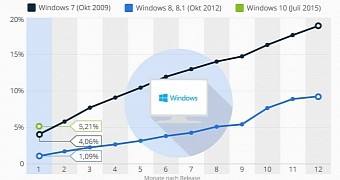Windows 10 has reached a market share of 5.21 percent after only 30 days on the market, and now that we finally have these first adoption figures, we can have a look back at how its predecessors performed and see if Microsoft is on the right path or not.
A comparison chart put together by Statista shows that Windows 10 indeed performed better than Windows 7 and 8.1 in the first 30 days on the market, which is an indication that, at least until now, adoption of the new operating system is going not necessarily as expected, but in a pretty satisfying way.
Net Applications puts Windows 10 at 5.21 percent after the first month on the market, and this makes it more successful than Windows 7, which reached only 4.06 percent after the same period of availability. Windows 8 is obviously even more behind, as its adoption only climbed to 1.09 percent after one month.
Windows 7 vs. Windows 10
As you can see in the chart, Windows 7 had a terrific growth after the first weeks in the wild, and it's a well-known fact that it quickly became the number one desktop operating system out there, so it'll be hard for Windows 10 to dethrone it and get the leading spot.
But they're both very similar in a number of ways, and we're not only referring to the feature lineup (Microsoft itself admitted that some Windows 10 features are inspired by those on Windows 7).
For instance, they both come after a very disappointing OS release: in Windows 7's case, it was Windows Vista, while Windows 10 launched after Windows 8.1, which was often referred to as the second Vista.
But Windows 10 also has a pretty big advantage, as Microsoft's offering it free of charge to users of Windows 7 and Windows 8.1, which obviously increases its customer appeal. Windows 7 never had such an opportunity, but it reached record market share anyway, so it'll be interesting to see how Windows 10 improves over time.

 14 DAY TRIAL //
14 DAY TRIAL //